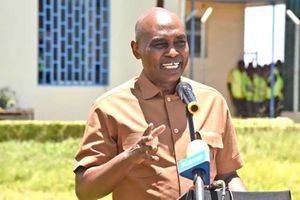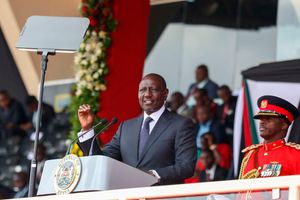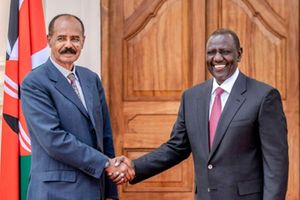
Nairobi Governor Johnson Sakaja.
He has earned the nickname ‘Dimples’ for the prominent feature on his cheeks that highlights his youthful good looks, but Nairobi Governor Johnson Sakaja is a man under siege.
Much of the pressure is coming from within his own party as President William Ruto’s United Democratic Alliance holds pivotal national elections.
The Nairobi contest is attracting plenty of national interests as the governor seeks the county party chairmanship against Embakasi North MP James Gakuya who is said to have the support of Deputy President Rigathi Gachagua.
How events are shaping up could be exemplified by the vicious attacks on Sakaja launched two weeks ago by a group of Nairobi UDA MPs and Members of County Assembly led by Dagoretti South MP John ‘KJ’ Kiarie.
Sakaja was accused of misdeeds ranging from arrogance, mismanagement onto high-level corruption.
Severity of the charges suggests that if critics from UDA within the County Assembly could marshal the numbers, an impeachment motion would be the next step. But his critics might not have the numbers. Under ordinary circumstances, KJ and Sakaja should be the firmest of allies.
They are amongst a crop of youthful, modern, suave and cosmopolitan Nairobi politicians who came to the fore with the advent of the 2013 Jubilee coalition regime of President Uhuru Kenyatta and then-Deputy President William Ruto.
Both are far removed from the rustic, thuggish types that previously dominated city politics, easily able to mix freely across class, ethnic and party divides.
KJ was in opposition chief Raila Odinga’s ODM before crossing over to Jubilee, and after the UhuRuto fallout to the incumbent president’s UDA. In Dagoretti South he was elected in in multi-ethnic constituency where he must cultivate support across all divides.
Sakaja first came to the National Assembly as a nominated MP, before securing as election as Nairobi Senator in a county where Raila’s opposition troops were dominant.

Nairobi Governor Johnson Sakaja speaking at Uhuru Park in Nairobi on September 11, 2023.
In being elected governor, he carried the day for UDA and the Kenya Kwanza alliance despite ODM and the Azimio alliance winning the majority of seats in both Parliament and the County Assembly, as well as dominating the presidential vote.
His victory was therefore on account of his own popularity rather than a reflection of support for Ruto or Kenya Kwanza in the capital city. He acknowledges freely that he runs a minority government, and therefore has no choice to cohabitate with the Azimio majority.
Right from the early days of his tenure, Sakaja made it public that he had reached out, with Ruto’s blessing, to Azimio leader Raila Odinga in a bid to ensure that his work and his efforts were not unnecessarily impeded.
He has also cultivated a working relationship with Wiper Party leader and Azimio co-principal Kalonzo Musyoka.
So, where did it all go wrong? Sakaja and KJ go back a long way.
Before venturing into politics, both had separately cut their teeth in the entertainment arena, with the future governor part of a burgeoning Nairobi music scene with a couple of recordings on his discography.
The future MP became a big star as part of the pioneering Redykyulass comedy trio out of Kenyatta University that exploded on local TV screens at the turn of the millennium. In separate conversations with The Weekly Review, both Sakaja and KJ agreed that they were once very close friends as well as political allies.
Indeed, their paths still cross frequently beyond politics, in common social circles and various social media discussion groupings. Sakaja attributes it all to politics that extend beyond his former ally to maneuvers around competition for political dominance on the city and onto the national scene.
“Less than two months ago, he (KJ) was heaping accolades on me as the best governor Nairobi has ever had since the advent of devolution. It’s just political interests. How you say I’m the best governor ever and shortly afterwards I’m the worst? Sakaja poses.
One point of departure is the UDA party elections where Sakaja’s candidacy is facing opposition from the team backing Gakuya. The governor does not want to be seen blaming Gachagua for his woes, but it is clear he sees a connection in the fight for control of Nairobi, and the DP positioning himself to eventually gun for the presidency when Ruto’s term expires. The resultant factionalism within both UDA and the Kenya Kwanza coalition has thus taken on ethnic dimensions.
This was witnessed openly early in the Ruto administration when the DP and politicians from some Mt Kenya counties hit out at Sakaja for allegedly victimising the Kikuyu business community in the city when trying to bring order to the matatu industry and hawking business. Politicians from western Kenya allied to Prime Cabinet Secretary Musalia Mudavadi, a Gachagua rival in the Ruto succession battles, rallied to Sakaja’s defence.
Also Read: Musalia Mudavadi - The rise of the phantom
Political battle aside, there are also very pertinent issues being raised about the state of Nairobi. The legendary maladministration and corruption is coming to haunt Sakaja as citizens launch a litany of complaint about dry taps, potholed roads, burst sewers, uncollected garbage, parts of Central Business District made no-go zones by unruly matatus and hawkers, unplanned development and mushrooming of high-rise buildings in once quiet suburbs.
KJ concedes that Sakaja and he were once close, but now charges that the governor has become inaccessible. “When you saw Nairobi leaders come out, UDA MP’s, MCAs and others, that because it had reached a point where you don’t have any contact with the governor,” he says of the decision to raise complaints publicly. “He spends most of his time sponsoring squabbles and funding conflicts to unsettle the elected leaders.

Deputy President Rigathi Gachagua who is also UDA party Deputy Party leader is handed the UDA compliance certificate by party Secretary General Cleophas Malala on June 26, 2023 at the party headquarters in Nairobi
The bigger issue is that everybody can see the city government is not functional. You’d imagine that for a city like Nairobi, the very basic would be a plan, a semblance of a blueprint or masterplan, a vision. As we speak we don’t know what plan we are working with.” He says that the county government can hardly account for Sh20 billion it gets from the National Treasury and an almost equal amount in ownsource revenue collections (The figure is closer to half that), charging that most of the money is lost to massive corruption, so there is very little in development to be seen.
“You’d imagine that Nairobi leaders have a forum, but it does not exist. It would behove a leader to call others leaders to a roundtable discussion, but there is, none” he says accusing Sakaja of being a lone ranger tryi n g t o govern without liaison with MPs and MCAs.
According to KJ, there was at least a semblance of order of the Evans Kidero administration between 2013 and 2017, despite the rampant corruption reported in that period.
Also Read:UDA party polls, mergers and the curse of DPs: Kibaki, Saitoti woes and lessons for Gachagua
Then came the regime of the flashy Governor Mike Sonko between 2017 till cut short by impeachment in 2020, which KJ describes as total chaos. Sonko was succeeded by his deputy Ann Kananu to serve out the remainder of his term till 2022, but was merely a figurehead as almost critical functions had been transferred to the Nairobi Metropolitan Services under the command of Lt-Gen Mohammed Badi, appointed by then-President Uhuru Kenyatta after Sonko signed a deed of transfer shortly before his ouster.
The suggestion that Sakaja’s administration is worse than Sonko’s is a severe indictment. The governor’s critics have pointed out numerous documented cases of brazen theft of county funds flagged in successive reports of the Auditor-General.
A look at the reports shows that many of the cases preceded Sakaja, dating back to the Kidero, Sonko and Badi tenures. However, Sakaja could still be held culpable for the manner in which billions in inherited pending bills due to contractors and service providers are being paid out in what some say is corrupt and opaque methods involving demands for kickbacks.

Nairobi County Governor Johnson Sakaja speaks during the launch of Nairobi County bursaries and scholarships at Nairobi Primary School on January 13, 2024.
On shenanigans around the UDA polls which started at the grassroots last Friday, KJ pleads that he would like to see that handled separately from issues around Sakaja’s stewardship of the county.
“It so happens that party polls involve the same personalities, so lines become blurred. The polls are a longdrawn-out affair, and issues of Nairobi cannot wait for party elections to end”.
He says it is a just a coincidence that the issues came up at the same time, saying that the spur was release of the audit report presently under discussion.
He concedes that Nairobi problems can not all be heaped on the current governor as many of the audit queries are historical and the county has been in decline for decades.
“But that doesn’t exonerate him, because when you step in and find a mess, the first thing is to steady the ship”.
On the issue of Gachagua, who is also in charge of the UDA poll machinery, sponsoring moves against Sakaja, KJ says he is not aware adding that he imagines both the President and the DP would want Nairobi issues sorted by Nairobi people.
On his part, the governor continues to insist that the assault on him is political rather than related to any actual mismanagement of Nairobi.
According to him, various interested groupings who were previously on the capital city gravy train in supply of goods and services are angry at the measure he has put in place to stem massive revenue leaks.
He trots out figures indicating impressive gains in revenue collections as well as significant developments in school construction and renovations, his signature school feeding programme, bursaries, health services, new markets, drainage works and roads.
He also points out ongoing projects around increasing water supply, expanding sewage systems, and improvement of the commuter transport network, all geared towards scaling up infrastructure designed for a city of two million to cope with a population of more than five million. Unfortunately, however, the major projects he cites are still some distance from fruition, while the problems being flagged are here and now.

Nairobi County Governor Johnson Sakaja addresses participants during the groundbreaking ceremony to pave way for the construction of the new Mutuini Market in Dagoretti on February 7, 2024.
One of the issues he faces is what seems uncontrolled approval of highrise buildings in Nairobi’s once pristine Kilimani, Kileleshwa and Lavington areas, leafy residential areas turning into concrete jungles. He has fought a running war with political activist Jerotich Seii over the skyscrapers shutting out the sunshine for residents of those suburbs, many of them built in total disregard of zoning restrictions and regulations on issues such as maximum built-up areas within a plot, distances to be left clear between boundaries, and provision of parking and open spaces.
There has also been no effort to widen roads and enhance water and sewerage services to cope with increased traffic and population. Seii charges that many of the building approvals have been secured through corruption, but Sakaja, for a while, remained unapologetic.
He caused outrage after insisting at a recent function attended by Ruto that “the way to go is up”, but not long afterwards seemed to beat a retreat by suspending all fresh approvals for building permits and instituting a review into those issued over the last two years.
“It is not the governor who approves building plans,” he says in response to accusations that he was personally involved, “but an urban planning technical committee with representation of various professionals including urban planners, the Institute of Engineers, Architectural Association of Kenya, Kenya Association of Residents Associations, and others”.
He however insists that high density, high-rise housing is the way to cope with the burgeoning urban population. In the process, some of those enjoying wide open spaces will have to adjust, giving himself as an example of one who moved into an area with plenty of trees and open air, but now has to suffer a highrise next door.
If he can’t stand in, he might have to move elsewhere. He, however, insists that zoning laws are still in place and building permits will not be issued haphazardly.
He adds that if residents of certain areas resolve to restrictions on buildings heights and use, they will be respected. That does not then explain his rejection of resident complaints in Kilimani.
On allegations that there is no plan, he reveals the establishment of a Nairobi Vision 2050 task force, taking a leaf for the Nairobi We Want gathering convened by former Nairobi Mayor Steve ‘Magic’ Mwangi in 2003, and former President Mwai Kibaki’s Kenya Vision 2030.
He has also appointed a task force chaired by lawyer Kamotho Waiganjo to look into the vexing issue of inherited pending bills that had ballooned to over Sh100 billion. What has generated much interest is pending legal fees over Sh10 billion owed to just 10 lawyers. Controversial Nairobi lawyer Donald Kipkorir, who is claiming over Sh1 billion, recently claimed on a social media rant that he had been approached by City Hall emissaries to part with a bribe of 50 per cent of the amount so he can be paid.
He vowed not to pay a penny and said he would report the matter to the Directorate of Criminal Investigations. Sakaja responded by denying ever having sent anyone to Kipkorir, challenging the lawyer to identify the supposed emissaries by name.
“I will not pay one lawyer an amount equal to 10 per cent of our own-source revenue,” Sakaja insisted, saying that Kipkorir had not responded to his challenge to name specific individuals who allegedly approached him, and neither made his threat to report to DCI.
He also disclosed that he was suing Kipkorir for defamation, saying he’d never met the lawyer, called him or sent envoys, but to the contrary had resisted his overtures. Kileleshwa Ward MCA Robert Alai, a controversial blogger, is looking on with interest at the goings-on Hall.
He is from the majority ODM-Kenya Kwanza grouping, and understands that as long as Sakaja commands support from both sides, threats to impeach him will get nowhere.
He opines that the matter is bigger than City Hall because no move can succeed against Sakaja without approval of both President Ruto and Opposition chief Raila, saying that the majority of MCAs from both Azimio and Kenya Kwanza take the lead from their party chiefs. “Baba (Raila) is very comfortable.
Sakaja calls him ‘Dad’,” says Alai, but cautions that the governor could make a serious mistake if he assumes he doesn’t need to secure support of MCAs as long as he has support from the party bigwigs.
Eyebrows were raised recently when Alai caught the attention of Gachagua at a public event, who urged him to keep playing a watchdog role over City Hall. Gachagua, who said he’d never met the controversial activist before, was essentially telling an opposition MCA to keep pressure on a ruling party governor, but Alai denies that he was being recruited into the anti-Sakaja camp.
He would never be for or against Sakaja, but believes that moves against the governor are a reflection of intense infighting within UDA around the Ruto succession and desire of the Gachagua camp to control the capital city.
He also believes that Ruto would not back any move to remove the Governor because that would hand the seat to his deputy James Muchiri, who he says is a Gachagua man.
If the numbers hold true, Sakaja should be sitting pretty comfortable despite the moves launched by KJ and others.
However, he must still be accountable to the people of Nairobi, and that is where the problem is for his prospects of a second term could dim if the city does not regain its lost glory.
For now, he is managing a balancing act of heading a minority government with only 35 out of 85 elected MCAs.
UDA also has only four out of 17 elected Members of the National Assembly, and also lost out on the contest for Senate and Women Representative.













